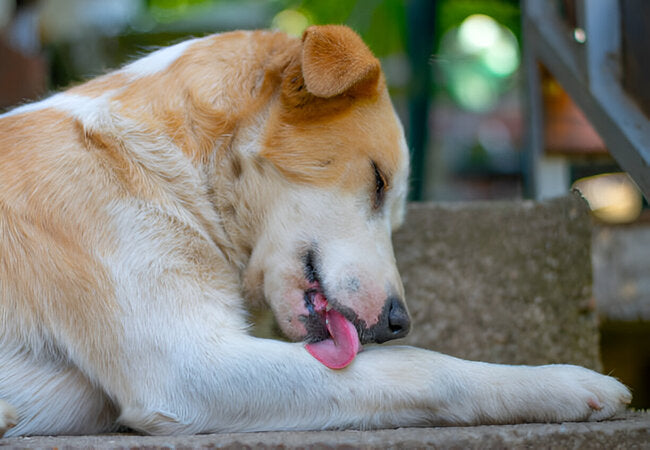Why Do Dogs Lick Wounds? Vet Insights & Safety Tips 2025 ✅🐾

In this article
Why Do Dogs Lick Wounds? Vet Insights & Safety Tips 2025 🐾
By Dr. Duncan Houston BVSc
When your dog licks a wound, it may seem caring or healing, but in 2025, we know it’s a reflex ingrained by evolution. Let’s explore the biology, benefits, and dangers, and how to handle your dog’s wound care with expert guidance.
1. Instinctive Cleansing & Comforting 🔍
Wound licking helps remove dirt, debris, and loose tissue, acting like a natural cleanser. Dogs lack hands—they use their mouths to soothe themselves. This behavior reduces pain and itch through over-stimulation of nerve endings.
2. Biochemical “Healing” Properties 🧪
Dog saliva contains enzymes, proteins, and nitric oxide that show mild antibacterial and healing properties, such as lysozyme, histatins, and nerve growth factors. Small wounds heal faster in animal's mouth than elsewhere.
3. Risks of Over-Licking 🚨
Despite its short-term benefits, excessive licking can cause:
- Wound irritation, redness, or hot spots
- Reopened stitches or slower healing
- Introduction of harmful bacteria like Pasteurella, E. coli, or Staph.
- Self-trauma—granulomas, infection, delays.
4. When Licking Is Helpful (But Usually Not) 👍/👎
In very mild cases, natural saliva may help with cleaning and pain relief, but modern antiseptics are safer and more effective. Rely on veterinary care instead.
5. How to Safeguard and Manage Licking
- Initial vet care: Clean the wound properly, apply antiseptics, and close or dress if needed.
-
Use protective barriers:
- Plastic, soft, or inflatable Elizabethan collars (e‑collars)
- Recovery suits or T-shirts for body wounds
- Booties/socks for paw injuries.
- Limit bandages: Vet‑applied dressings only—over-tight ones risk poor circulation or infections.
- Distract & enrich: Offer toys or scent mats to shift focus when licking urges arise.
- Monitor grooming: Note moisture, redness, odor, or swelling—signs of infection.
- Keep it clean: Fresh water, short nails, and dry bedding reduce irritants.
6. Healing vs. Infection: Know the Signs
- Clean healing: Pink, no swelling, closing wound
- Infection warning signs: Oozing, redness, bad smell, warmth, pain, reopened edges — see your vet.
7. Vet-Safe Products for At-Home Care
Use veterinarian-approved topical sprays or antiseptics rather than home remedies. Saline solution, chlorhexidine washes, or pus-free dressings offer better safety than saliva or DIY sprays.
8. Timeline & When to Seek Help
- Short-term licking is normal to start.
- If persistent after 48 h, take action.
- If signs of infection appear, visit your vet immediately.
- Surgical sites typically heal in 10–14 days; use protection throughout.
9. Step-by-Step 2025 Owner Action Plan 📋
- 💉 Get the wound professionally treated.
- 🛡 Use an e-collar, suit, or sock to block access.
- 🔄 Clean the area daily and check for infection.
- 🎾 Distract with enrichment or guided walks.
- 📓 Journal progress—note licking, wound appearance.
- 📲 Use the Ask A Vet app to log, consult, and request product help.
FAQs 💬
• Is licking okay if the wound is tiny?
For small scrapes, brief, gentle licking isn't alarming, but still cover at night and monitor to prevent infection.
• Will dog saliva harm humans?
Yes—dogs’ mouths carry bacteria like Pasteurella. Human wounds in contact with dog saliva risk serious infection.
• Can I use a “no‑chew” spray on the wound?
Only with your vet’s go-ahead. Some sprays are irritating or impede healing.
• My dog refuses to wear a cone—what else can I do?
Try soft/inflatable collars, recovery suits, T-shirts, or booties. Distraction and wound coverage are important to protect healing skin.
Conclusion ❤️
Licking is rooted in evolution, but in modern pet care, it’s better controlled than endorsed. Saliva may help clean or soothe, but it introduces real risks. In 2025, ensure your dog’s wound heals smoothly through proper treatment, protective gear, hygiene, and distraction. When in doubt, reach out to veterinary experts—through Ask A Vet, trusted first-aid kits, or local clinics—for safe and effective recovery support. 🐕
Need help right now? Visit AskAVet.com or download the Ask A Vet app for expert guidance anytime.


